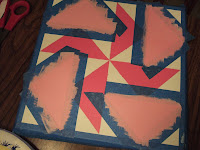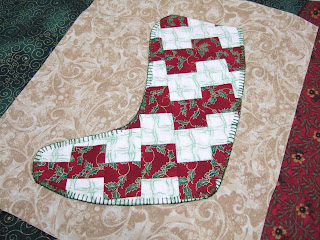I'm often asked, "How do you like to apply binding?" Below is a tutorial I'm glad to offer. This binding method is one with no joining, and machine-sewn mitered corners. If you haven't tried it, I encourage you to do so.
No Tails Binding Tutorial
Begin by preparing double-fold binding (AKA French binding) in one long continuous strip. My favorite width is cut 2-1/4".

Note: Do not trim backing and batting at this time. First sew binding to the quilt; then trim.
Lay the untrimmed quilt, face up, on a flat surface, smoothing out wrinkles.
This is also an opportunity to make sure your quilt layers are square.
Use a long ruler to draw straight lines along each side - around the entire perimeter - of the quilt. You will use this straight edge as a guideline for sewing binding to the quilt.
Following a straight line will ensure you end up with a squared quilt and straight binding.
Cut and Sew Binding Across Quilt Width
Lay the binding across the width of the quilt, approximately in the center. Leave a 2" to 3" tail extending beyond both edges of the quilt top. Gently smooth and pat the binding flat.
Cut the binding 2" to 3" from the edge of the quilt top.
Repeat, to make a second piece of binding for the width of the quilt.

Insert a pin, or make a mark at the point where the binding meets the edge of the quilt top. See blue pin.

Insert another pin, or make a mark at a point 1/4" to the inside of the first pin.
The pink pin marks the sewing stop-start point. Remove the blue pin.

Now, focusing on the corner of the quilt top,
measure 1/4" from each side of the quilt top. Use a pin or make a mark at the spot.

Repeat at the opposite end of the binding, marking the binding and marking the quilt top.
Position the binding along the edge of the squared quilt top. Pin.


Begin sewing at the pinned or marked spot on the binding. Backstitch.

Continue sewing binding to the quilt, stopping at the pin or mark at the opposite end. Backstitch.

Repeat the above steps to sew the second binding to the width of the quilt.
Cut and Sew Binding for Quilt Length
When you have sewn binding strips to the top and bottom of the quilt (across the width), again lay the quilt on a flat surface.
As when cutting the binding width, lay down binding along the length of the quilt, placing it approximately through the center of the quilt. Smooth and pat binding.
Insert a pin, or make a mark at the point where the binding meets the edge of the quilt top. Repeat for the second piece of binding.

At both ends of the two binding strips, insert another pin, or make a mark at a point 1/4" to the inside of the first pin.
Working at the corner, fold back the previously sewn binding to get it out of the way.

Match the unsewn binding start-stop point to the stopping point of the previously sewn binding.

Lay binding along along the straight edge of the quilt, pin across the binding length and matching the unsewn binding start-stop point to the stopping point of the previously sewn binding.
Sew binding to the quilt, beginning and ending with backstitches.
Repeat to apply the last binding strip.
Mark and Sew Binding Corners
At one corner, fold the quilt onto itself, back-to-back, to form a 45-degree angle. Position binding strips to form a straight horizontal line, meeting the binding's folded edge to the folded edge, and the raw edge to the raw edge.

Pin to hold into place. Use a small ruler perpendicular to the binding to make a small indication mark on the binding fold at a point parallel and directly above where the stitching ends.

Tip a small ruler so the ruler corner is positioned in the middle of the binding strip. Position the ruler point an equal distance from both the mark along the binding fold, and the end point of the stitching. Between each point the distance is 1/2" to 5/8".
Draw along the corner of the ruler to make a visible line that forms an arrow.

Sew on the drawn line: backstitch at the fold, sew, pivot at the point, sew, backstitch.

Trim 1/4" from the sewn line to remove binding tails. Snip the tip to reduce bulk.
Repeat steps, marking, sewing, and trimming on three more corners to sew a total of four mitered corners.
Finish Binding
From around the perimeter of the quilt, trim excess batting and backing 3/8" from stitching line. Be sure not to rotary cut the binding corner!
Turn the binding to the quilt back. Use a stiletto or point turner to pull out the points at each mitered corner. Admire these sturdy, machine-sewn mitered corners - you won't have to hand-sew them closed!

Using thread that matches the color of the binding, blind stitch to hand sew binding to the quilt back.











 Still, I like them. But can you believe it? They need another coat...
Still, I like them. But can you believe it? They need another coat...



























